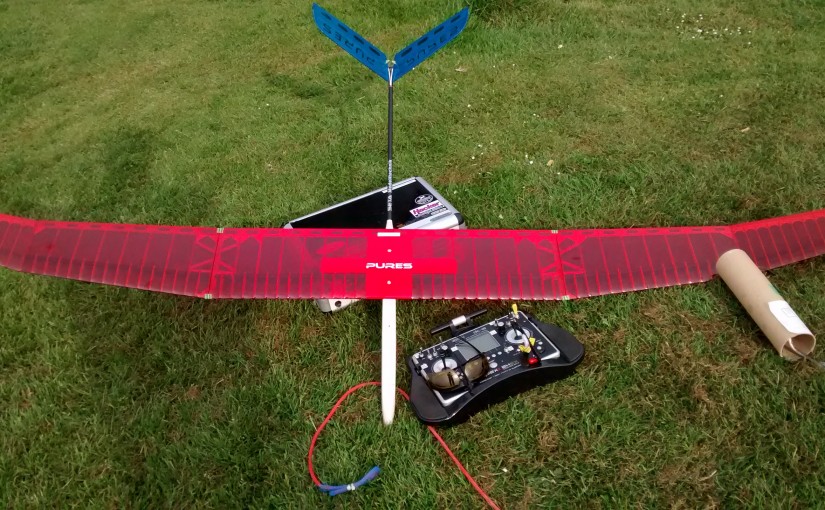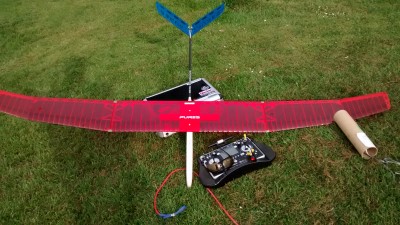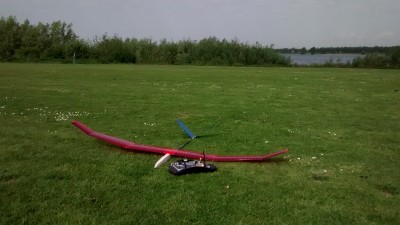As a first build in our new residence I got myself a few RES kits from Josef Gergetz. RES stands for Rudder Elevator and Spoiler. It´s a class of glider measuring 2 meters span, and it is very restricted as to the materials and construction used. It is intended as a low cost platform for lots of fun.
specs are:
| Name: | PURES V2 |
| SPW: | 1990 mm |
| Länge: | 1120 mm |
| Profil: | AG 35 – AG 36 Strak (Mark Drela) |
| Flächeninhalt: | 35,7 dm² |
| Abfluggewicht: | 670 g |
| Flächenbelastung: | ca. 19 g/dm² |
| Steuerung: V-Ltw: | Seitenruder, Höhenruder, Bremsklappe |
| EWD: | 0,7° |
| Schwerpunkt: | 75 – 80 mm |
There is a long article on RC-Networks, you can go and look at the pictures there and here.
We finally have a maiden! during the first fligths there was a mild westerly blowing from the lake. This usually goes together with turbulent air caused by the trees that line the shore. So lots of bumps are expected 😉
After a few tosses, I felt a bit more gravity was needed in the nose, and feeling brave, decided to try my bungee. This one was originally intended for the little DS-Birdie, but who cares. First launches were made with approx 30 meters rope, enough to get up and see what happens.
Things were a bit confusing at first. I had decided to slave my aileron stick to the rudder (dual control really) since the standard recipe sets everything up on rudder/elevator. I feel more comfortable having my directional control right, and elevator left. However, I did not check if wiggling my right stick did produce the same effect as wiggling the left stick. Anyway, you figure out pretty quick when things do not turn in the direction you anticipate. No harm was done to plane or pilot, so after teaching the tranny to move surfaces the same direction on both sticks, more fun was had.
Due to the freshening wind I could not really do much more then hang in there. Adding enough rope to span the entire field gets me up to approx 40-50 meters. I am not sure yet what the correct way to get rid of the rope is once you are at altitude. My feeling is that I should fly past the vertical, at wich point I should have reached maximum height, give a bit of down to release the tension on the wire to let go, and off to blue skies above. Due to the strongish wind I have the feeling I was more or less flying like a kite, untill pushing down pretty hard to release. Anyway, we will learn this trick too.
After lunch and a quick dash into the shed, I made a few bits of ballast. The main wingspar is a hollow 10 mm carbon tube, so it is easy to simply insert something. I had a few sizes of alu tube, which give me 60, 100 and 150 grams of ballast. (The plane RTF is 450 gram) . With the added weight (150 gram) the performance improved, I could fly against the wind and even make a few turns!
I just noticed that the stated RTF weight is 670 gram. Mine weighs RTF 450-ish. No wonder I needed to add ballast!! I must have forgotten to add some major parts to end up that low?? And I was contemplating making it even lighter! (Like get rid of the steel wires/tubing to drive the v-tail, use ligther servo’s etc. I now have 60 gram ballast up front, I can probably reduce the RTF by that much if I try hard.
Next time I hopefully will be able to try in more favorable conditions, after all this is a glider for these long windless summer evenings 😉
Todo: probably a good idea to stick this one on the same tranny as my DLG, it is a bit of overkill to use a Jeti tx for this. I will also move my little altimeter/vario here, to see what happens during launch.


